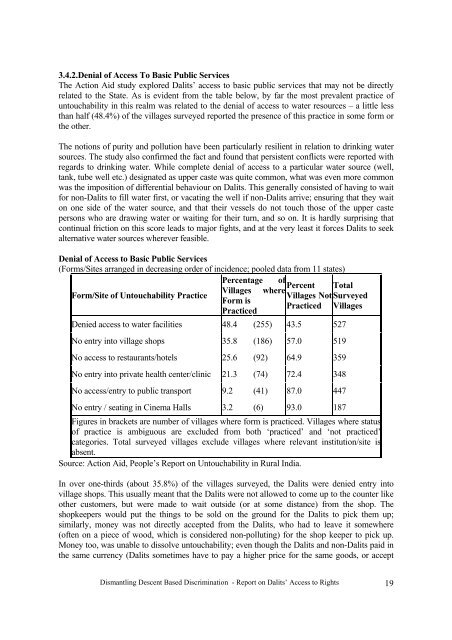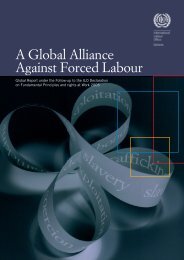dismantling dismantling descent-based discrimination based ...
dismantling dismantling descent-based discrimination based ...
dismantling dismantling descent-based discrimination based ...
You also want an ePaper? Increase the reach of your titles
YUMPU automatically turns print PDFs into web optimized ePapers that Google loves.
3.4.2.Denial of Access To Basic Public ServicesThe Action Aid study explored Dalits’ access to basic public services that may not be directlyrelated to the State. As is evident from the table below, by far the most prevalent practice ofuntouchability in this realm was related to the denial of access to water resources – a little lessthan half (48.4%) of the villages surveyed reported the presence of this practice in some form orthe other.The notions of purity and pollution have been particularly resilient in relation to drinking watersources. The study also confirmed the fact and found that persistent conflicts were reported withregards to drinking water. While complete denial of access to a particular water source (well,tank, tube well etc.) designated as upper caste was quite common, what was even more commonwas the imposition of differential behaviour on Dalits. This generally consisted of having to waitfor non-Dalits to fill water first, or vacating the well if non-Dalits arrive; ensuring that they waiton one side of the water source, and that their vessels do not touch those of the upper castepersons who are drawing water or waiting for their turn, and so on. It is hardly surprising thatcontinual friction on this score leads to major fights, and at the very least it forces Dalits to seekalternative water sources wherever feasible.Denial of Access to Basic Public Services(Forms/Sites arranged in decreasing order of incidence; pooled data from 11 states)Percentage ofPercent TotalVillages whereForm/Site of Untouchability PracticeVillages Not SurveyedForm isPracticed VillagesPracticedDenied access to water facilities 48.4 (255) 43.5 527No entry into village shops 35.8 (186) 57.0 519No access to restaurants/hotels 25.6 (92) 64.9 359No entry into private health center/clinic 21.3 (74) 72.4 348No access/entry to public transport 9.2 (41) 87.0 447No entry / seating in Cinema Halls 3.2 (6) 93.0 187Figures in brackets are number of villages where form is practiced. Villages where statusof practice is ambiguous are excluded from both ‘practiced’ and ‘not practiced’categories. Total surveyed villages exclude villages where relevant institution/site isabsent.Source: Action Aid, People’s Report on Untouchability in Rural India.In over one-thirds (about 35.8%) of the villages surveyed, the Dalits were denied entry intovillage shops. This usually meant that the Dalits were not allowed to come up to the counter likeother customers, but were made to wait outside (or at some distance) from the shop. Theshopkeepers would put the things to be sold on the ground for the Dalits to pick them up;similarly, money was not directly accepted from the Dalits, who had to leave it somewhere(often on a piece of wood, which is considered non-polluting) for the shop keeper to pick up.Money too, was unable to dissolve untouchability; even though the Dalits and non-Dalits paid inthe same currency (Dalits sometimes have to pay a higher price for the same goods, or acceptDismantling Descent Based Discrimination - Report on Dalits’ Access to Rights 19

















